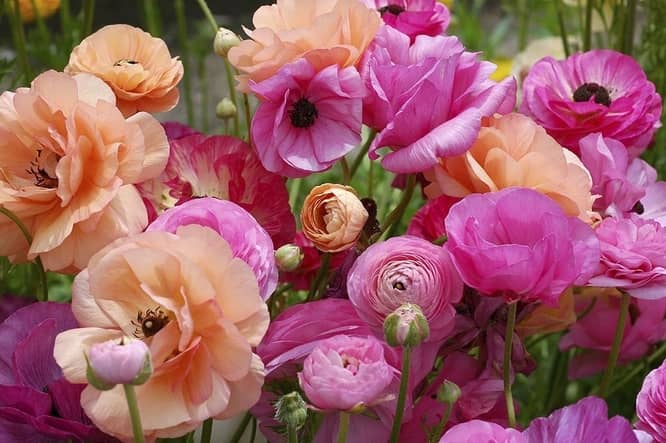Ranunculus Leaves Turning Yellow
Ranunculus leaves turning yellow due to a lack of nutrients can be fixed by fertilizing the plant.
The best fertilizer for ranunculus plants is a balanced fertilizer that contains nitrogen, phosphorus, potassium and iron.
You can apply the fertilizer to the soil around the plant or you can water the plant with a fertilizer solution.
If you are using a fertilizer solution, be sure to follow the instructions on the package.
What are the other reasons that might cause yellowing of ranunculus leaves?
There are several reasons why ranunculus leaves might turn yellow. It could be due to a lack of nutrients, too much water, or too much sun exposure.
If the leaves are turning yellow and falling off, it is likely due to a lack of nutrients. The best way to fix this is to fertilize the plant.
If the leaves are turning yellow but not falling off, it could be due to too much water or too much sun exposure.
If the leaves are turning yellow due to too much water, you should let the soil dry out before watering again.
If the leaves are turning yellow due to too much sun exposure, you should move the plant to a location that gets less sun.
Why is my ranunculus drooping?
There are a few reasons why your ranunculus may be drooping.
One possibility is that the plant is not getting enough water. Ranunculus need to be watered regularly, and if the soil is allowed to dry out, the plant will start to droop.
Another possibility is that the plant is getting too much sun.
If the leaves are starting to turn yellow and the plant is drooping, it may be because it is getting too much sun.
Move the plant to a location that gets less sun and see if that helps.
Why is my ranunculus stem bending?
There are a few reasons why the stem of your ranunculus may be bending.
One possibility is that the plant is not getting enough support. If the stem is not supported, it will start to bend over.
Another possibility is that the plant is too top-heavy. If the plant is top-heavy, it will also start to bend over.
The best way to fix this problem is to provide support for the stem or to trim back some of the leaves and flowers so that the plant is not as top-heavy.
Why are ranunculus leaves turning yellow and falling off?
The most likely reason why ranunculus leaves are turning yellow and falling off is a lack of nutrients.
How often should you water your ranunculus plant?
Ranunculus need to be watered regularly, and if the soil is allowed to dry out, the plant will start to droop.
The best way to water ranunculus plants is to give them a deep watering once a week. During hot weather, you may need to water more frequently.
Be sure to check the soil before watering to make sure that it is dry. If the soil is still moist, you don’t need to water.
Overwatering can also be a problem, so be sure not to water more than necessary.
Why are my ranunculus not flowering?
Ranunculus might not be flowering because it is not getting enough sun. Ranunculus need at least six hours of sunlight each day in order to bloom.
How to tell if ranunculus is having iron deficiency?
Iron deficiency in ranunculus is indicated by yellowing of the leaves between the veins, with the veins remaining green. This is called interveinal chlorosis.
Other symptoms of iron deficiency include stunted growth and reduced flowering.
Iron deficiency is most commonly caused by a lack of iron in the soil. This can be due to soil that is too alkaline or too wet.
The best way to fix iron deficiency is to apply an iron fertilizer to the soil around the plant.
Common Fungal Disease in ranunculus plant?
One of the most common fungal diseases that affects ranunculus is powdery mildew.
Powdery mildew looks like gray or white powder on the leaves and stems of the plant. It can cause the leaves to turn yellow and drop off.
The best way to prevent powdery mildew is to water early in the day so that the leaves have time to dry before nightfall.
If powdery mildew does occur, you can treat it with a fungicide.
Pests that commonly affect ranunculus plants?
There are a few pests that commonly affect ranunculus plants.
One of the most common is the aphid. Aphids are small, green insects that suck the sap out of plants.
They can cause the leaves to turn yellow and drop off.
The best way you can prevent aphids is to keep your garden clean and free of debris. This will make it less likely for them to infest your plants.
If aphids do infest your ranunculus, you can treat them with an insecticide.
Other common pests that affect ranunculus include slugs, snails, and Japanese beetles.
All of these pests can be controlled with the use of pesticides.
Easy tips to care for ranunculus plant
Here are a few easy tips to care for ranunculus plants:
-Water regularly and deeply. Ranunculus need to be watered about once a week, but during hot weather, you may need to water more often.
-Provide support for the stem. If the stem is not supported, it will start to bend over.
-Trim back leaves and flowers if the plant is top-heavy. This will help to prevent the plant from bending over.
-Apply an iron fertilizer if the leaves start to turn yellow between the veins. This is a symptom of iron deficiency.
-Keep your garden clean and free of debris. This will make it less likely for pests to infest your ranunculus plants.
-Check for pests regularly and treat with pesticides if necessary.
Thanks for reading! I hope you found this information on ranunculus plants helpful. Be sure to check back soon for more gardening tips and tricks.
Also Read: Why is My Banana Plant Drooping After Repotting? Easy Fix!

